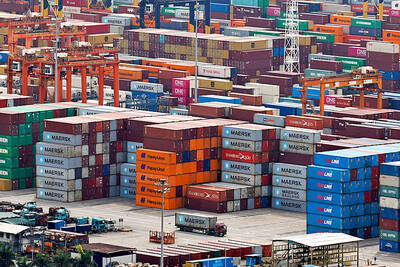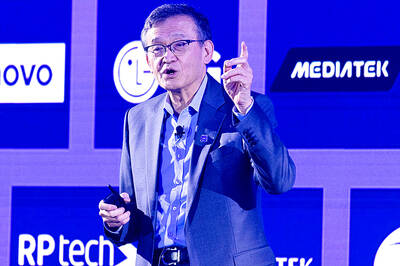Apple Inc is moving forward with self-driving vehicle technology and is targeting 2024 to produce a passenger vehicle that could include its own breakthrough battery technology, people familiar with the matter told reporters.
The iPhone maker’s automotive efforts, known as Project Titan, have proceeded unevenly since 2014, when it first started to design its own vehicle from scratch.
At one point, Apple drew back the effort to focus on software and reassessed its goals.

Photo: Reuters
Doug Field, an Apple veteran who had worked at Tesla Inc, in 2018 returned to oversee the project and laid off 190 people from the team last year.
Since then, Apple has progressed enough that it now aims to build a vehicle for consumers, two people familiar with the effort said, asking not to be named because Apple’s plans are not public.
Apple’s goal of building a personal vehicle for the mass market contrasts with rivals such as Alphabet Inc’s Waymo, which has built robo-taxis to carry passengers for a driverless ride-hailing service.
Central to Apple’s strategy is a new battery design that could “radically” reduce the cost of batteries and increase the vehicle’s range, according to a third person who has seen Apple’s battery design.
Apple declined to comment on its plans or future products.
Making a vehicle represents a supply chain challenge even for Apple, a company with deep pockets that makes hundreds of millions of electronics products each year with parts from around the world, but has never made a car.
It took Elon Musk’s Tesla 17 years before it finally turned a sustained profit making vehicles.
“If there is one company on the planet that has the resources to do that, it’s probably Apple, but at the same time, it’s not a cellphone,” a person who worked on Project Titan said.
It remains unclear who would assemble an Apple-branded vehicle, but sources have said they expect the company to rely on a manufacturing partner to build them.
There is still a chance that Apple will reduce the scope of its efforts to an autonomous driving system that would be integrated with a car made by a traditional automaker, rather than the iPhone maker selling an Apple-branded vehicle, one of the people said.
Two people with knowledge of Apple’s plans warned that COVID-19 pandemic-related delays could push the start of production into 2025 or beyond.
Apple has tapped outside partners for elements of the system, including light detection and ranging (LIDAR) sensors, which help self-driving cars get a 3D view of the road, two people familiar with the company’s plans said.
Apple’s vehicle might feature multiple LIDAR sensors for scanning different distances, another person said.
Some sensors could be derived from Apple’s internally developed LIDAR units, that person said.
Apple’s iPhone 12 Pro and iPad Pro models released this year feature LIDAR sensors.
As for the car’s battery, Apple plans to use a unique “monocell” design that bulks up the individual cells in the battery and frees up space inside the battery pack by eliminating pouches and modules that hold battery materials, one of the people said.
Apple’s design means that more active material can be packed inside the battery, giving the car a potentially longer range.
Apple is also examining a chemistry for the battery called lithium iron phosphate, which is inherently less likely to overheat and is thus safer than other types of lithium-ion batteries, the person said.
“It’s next level,” the person said of Apple’s battery technology. “Like the first time you saw the iPhone.”
Apple had previously engaged Magna International Inc in talks about manufacturing a car, but the talks petered out as Apple’s plans became unclear, a person familiar with those previous efforts said.
Magna did not immediately respond to a request for comment.
To turn a profit, automotive contract manufacturers often ask for volumes that could pose a challenge even to Apple, which would be a newcomer to the automotive market.
“In order to have a viable assembly plant, you need 100,000 vehicles annually, with more volume to come,” the person said.
Some Apple investors reacted to the report on the company’s plans with caution.
Trip Miller, managing partner at Apple investor Gullane Capital Partners, said it could be tough for Apple to produce large volumes of vehicles out of the gate.
“It would seem to me that if Apple develops some advanced operating system or battery technology, it would be best utilized in a partnership with an existing manufacturer under license,” Miller said. “As we see with Tesla and the legacy auto companies, having a very complex manufacturing network around the globe doesn’t happen overnight.”
Hal Eddins, chief economist at Apple shareholder Capital Investment Counsel, said that Apple has a history of higher margins than most automakers.
“My initial reaction as a shareholder is: ‘Huh?’” Eddins said. “Still don’t really see the appeal of the car business, but Apple may be eyeing another angle than what I’m seeing.”

The Eurovision Song Contest has seen a surge in punter interest at the bookmakers, becoming a major betting event, experts said ahead of last night’s giant glamfest in Basel. “Eurovision has quietly become one of the biggest betting events of the year,” said Tomi Huttunen, senior manager of the Online Computer Finland (OCS) betting and casino platform. Betting sites have long been used to gauge which way voters might be leaning ahead of the world’s biggest televised live music event. However, bookmakers highlight a huge increase in engagement in recent years — and this year in particular. “We’ve already passed 2023’s total activity and

Nvidia Corp CEO Jensen Huang (黃仁勳) today announced that his company has selected "Beitou Shilin" in Taipei for its new Taiwan office, called Nvidia Constellation, putting an end to months of speculation. Industry sources have said that the tech giant has been eyeing the Beitou Shilin Science Park as the site of its new overseas headquarters, and speculated that the new headquarters would be built on two plots of land designated as "T17" and "T18," which span 3.89 hectares in the park. "I think it's time for us to reveal one of the largest products we've ever built," Huang said near the

China yesterday announced anti-dumping duties as high as 74.9 percent on imports of polyoxymethylene (POM) copolymers, a type of engineering plastic, from Taiwan, the US, the EU and Japan. The Chinese Ministry of Commerce’s findings conclude a probe launched in May last year, shortly after the US sharply increased tariffs on Chinese electric vehicles, computer chips and other imports. POM copolymers can partially replace metals such as copper and zinc, and have various applications, including in auto parts, electronics and medical equipment, the Chinese ministry has said. In January, it said initial investigations had determined that dumping was taking place, and implemented preliminary

Intel Corp yesterday reinforced its determination to strengthen its partnerships with Taiwan’s ecosystem partners including original-electronic-manufacturing (OEM) companies such as Hon Hai Precision Industry Co (鴻海精密) and chipmaker United Microelectronics Corp (UMC, 聯電). “Tonight marks a new beginning. We renew our new partnership with Taiwan ecosystem,” Intel new chief executive officer Tan Lip-bu (陳立武) said at a dinner with representatives from the company’s local partners, celebrating the 40th anniversary of the US chip giant’s presence in Taiwan. Tan took the reins at Intel six weeks ago aiming to reform the chipmaker and revive its past glory. This is the first time Tan